In order to generate a more inclusive dataset of Pseudomonas genes mapped to putative in-paralogs and putative orthologs in other Pseudomonas species/strains, we developed a Pseudomonas Orthologous Groups classification system.
To generate ortholog groups, pair-wise DIAMOND searches were run on all genomes in the database to find reciprocal best hits (RBHs) for each gene. These analyses often resulted in multiple candidate genes for RBH status, which were narrowed down by examining the similarity between the query's flanking genes and the hit's flanking genes. If two candidate genes were directly adjacent, they where both accepted as RBHs that involve putative in-parology.
Pairwise intra-genome DIAMOND searches were also performed to acquire in-paralog information (i.e. gene duplications occurring after species divergence). If two genes in one genome were reciprocally more similar to each other than to any gene in the other genomes, the two genes were designated putative in-paralogs. Ortholog groups are built by starting with a seed gene and then adding all genes to which there is a RBH or in-paralog relationship.
Every new gene added to an ortholog group was then treated as a seed gene and the addition process was repeated until all qualifying genes had been added. The result was the development of orthologous groups, specifically generated for Pseudomonas species genomes, which can be used to sort search results.
Pseudomonas Ortholog Group POG004897
| Strain | Locus Tag | Description | Same-Strain Members | Fragment ? | |
|---|---|---|---|---|---|
| Pseudomonas aeruginosa AZPAE14988 | NT03_RS09795 |
cytochrome
|
2 same-strain members: NT03_RS07400 NT03_RS09795 |
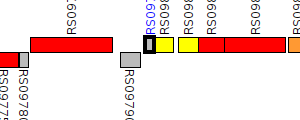
|
|
| Pseudomonas aeruginosa AZPAE14989 | NT04_RS22265 |
cytochrome
|
2 same-strain members: NT04_RS22265 NT04_RS28280 |
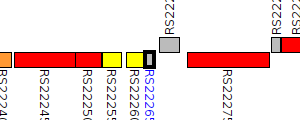
|
|
| Pseudomonas aeruginosa AZPAE14989 | NT04_RS28280 |
cytochrome C
|
2 same-strain members: NT04_RS22265 NT04_RS28280 |
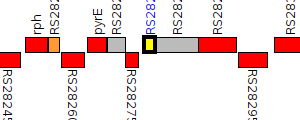
|
|
| Pseudomonas aeruginosa AZPAE14996 | NT11_RS13470 |
cytochrome
|
2 same-strain members: NT11_RS13470 NT11_RS18945 |

|
|
| Pseudomonas aeruginosa AZPAE14996 | NT11_RS18945 |
cytochrome C
|
2 same-strain members: NT11_RS13470 NT11_RS18945 |
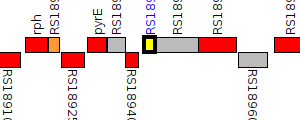
|
|
| Pseudomonas aeruginosa AZPAE15017 | NT33_RS25570 |
cytochrome C
|
2 same-strain members: NT33_RS25570 NT33_RS27405 |
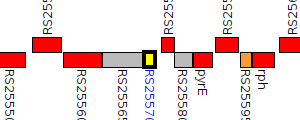
|
|
| Pseudomonas aeruginosa AZPAE15017 | NT33_RS27405 |
cytochrome
|
2 same-strain members: NT33_RS25570 NT33_RS27405 |
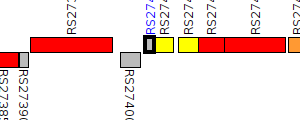
|
|
| Pseudomonas aeruginosa AZPAE15022 | NT38_RS22605 |
cytochrome
|
2 same-strain members: NT38_RS22605 NT38_RS24565 |

|
|
| Pseudomonas aeruginosa AZPAE15022 | NT38_RS24565 |
cytochrome C
|
2 same-strain members: NT38_RS22605 NT38_RS24565 |
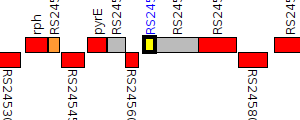
|
|
| Pseudomonas aeruginosa AZPAE15025 | NT41_RS22540 |
cytochrome C
|
2 same-strain members: NT41_RS22540 NT41_RS25690 |

|
|
| Pseudomonas aeruginosa AZPAE15025 | NT41_RS25690 |
cytochrome
|
2 same-strain members: NT41_RS22540 NT41_RS25690 |

|
|
| Pseudomonas aeruginosa AZPAE15026 | NT42_RS27915 |
cytochrome C
|
2 same-strain members: NT42_RS25435 NT42_RS27915 |
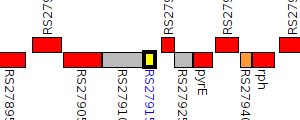
|
|
| Pseudomonas aeruginosa AZPAE15026 | NT42_RS25435 |
cytochrome
|
2 same-strain members: NT42_RS25435 NT42_RS27915 |

|
|
| Pseudomonas aeruginosa AZPAE15032 | NT48_RS22345 |
cytochrome
|
2 same-strain members: NT48_RS22345 NT48_RS26505 |
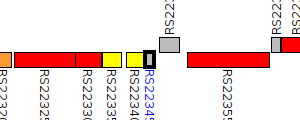
|
|
| Pseudomonas aeruginosa AZPAE15032 | NT48_RS26505 |
cytochrome C
|
2 same-strain members: NT48_RS22345 NT48_RS26505 |

|
|
| Pseudomonas aeruginosa AZPAE15033 | NT49_RS14585 |
cytochrome
|
2 same-strain members: NT49_RS14585 NT49_RS27570 |
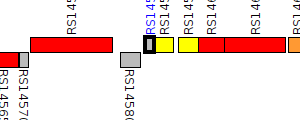
|
|
| Pseudomonas aeruginosa AZPAE15033 | NT49_RS27570 |
cytochrome C
|
2 same-strain members: NT49_RS14585 NT49_RS27570 |

|
|
| Pseudomonas aeruginosa AZPAE15055 | NT71_RS25740 |
cytochrome C
|
2 same-strain members: NT71_RS25740 NT71_RS26440 |

|
|
| Pseudomonas aeruginosa AZPAE15055 | NT71_RS26440 |
cytochrome
|
2 same-strain members: NT71_RS25740 NT71_RS26440 |
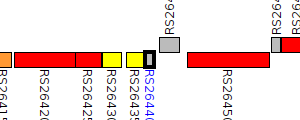
|
|
| Pseudomonas aeruginosa AZPAE15065 | NT81_RS22020 |
mono-heme cytochrome C
|
2 same-strain members: NT81_RS22020 NT81_RS08775 |
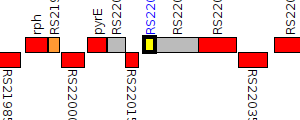
|